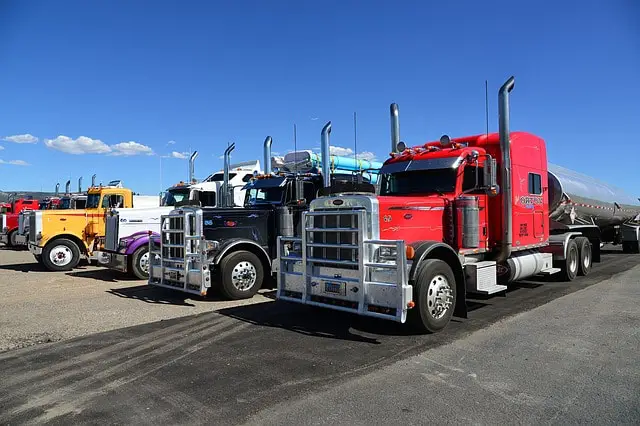If you’ve ever driven around a truck stop before at night, you most likely saw long rows of semi-trucks parked for the night. If your window was down or you walked inside the truck stop, you probably also noticed a low hum of engines running. If so, you probably asked yourself why a trucker leave their engines running throughout the night? Logic would say that there must be a significant amount of money being wasted by burning fuel while the truck is parked. In the article below, we will answer these questions and several others that you likely have had at some point.
Fuel Consumption During Idle
According to a study by the Alternative Fuel Data Center (AFDC), an idling semi-truck uses approximately .8 gallons of diesel for every hour that it sits idling. With gas prices hovering around $3 per gallon for diesel fuel at the time of this writing, that would equate to about 6.5 gallons of diesel fuel being burned during an 8-hour period of idling. Cost wise, that comes out to about $24 for that same period of idling.
Amazingly, some of the newer models of trucks are extremely fuel efficient. It’s hard to imagine that a 400-horsepower engine can ever be described as fuel efficient, but they can perform better than some small cars.
Why Do it?
If letting a semi-truck sit and idle is costing the driving about $3 an hour, why would they do it? Why not just turn the truck off, especially if they are just sleeping? There’s several reasons that truckers do this.
The primary reason that truckers leaving their trucks idling during the night is to regulate the temperature inside their truck while they are sleeping. Many times, the insulation of the cab is good enough that drivers can sleep comfortably in the cab of their truck. However, when outside temperatures are extremely hot or cold, it will easily impact the temps inside the cab. The only option available to drivers to help control the temps to sleep comfortably is the keep their truck running.
 Another primary reason that truckers keep their trucks idling at night is to prevent the battery from dying. Most trucks have small motors dedicated to running small electronics in the cab of the truck. However, the power produced from these small motors is limited. If a driver has a TV or small cooking appliance they need to power up, they will be forced to keep the truck running to ensure the alternator keeps the battery charged for longer periods of times.
Another primary reason that truckers keep their trucks idling at night is to prevent the battery from dying. Most trucks have small motors dedicated to running small electronics in the cab of the truck. However, the power produced from these small motors is limited. If a driver has a TV or small cooking appliance they need to power up, they will be forced to keep the truck running to ensure the alternator keeps the battery charged for longer periods of times.
Interestingly, many drivers have also mentioned they keep their truck running for the same reason many people sleep with a sound machine. The slow hum and light vibration of the idling truck works like white noise and helps reduce the noises from the truck stop or passing cars and trucks if they are parked on the side of the road. Trucks are always on the move. Many drivers plan their trips to leave out well before sunrise to get a jump on traffic or to make a delivery. Trying to sleep in your cab with the surrounding trucks starting and leaving can make it very difficult to get a good night’s sleep.
Engine Care
It’s easy to assume all motors are the same and the motors in our cars are the same as any other motor that you might find in a lawn mower or semi-truck except for its obvious size. This is a common misconception. Diesel engines are significantly different that regular gasoline engines.
Many truckers leave their trucks running to keep their engines warm. Diesel trucks need a period of time to warm up before they head out on the road pulling several tons of cargo down the interstate at 60+ MPH. Therefore, many truckers will keep the trucks running to keep them warm and to keep oil and coolant circulating the motor.
Extremely cold temperatures can create havoc on a truck running diesel. In fact, diesel fuel will thicken as it gets cold. Sometimes, it gets so thick that it can’t flow properly thru the fuel lines and fuel pump. Once it reaches this point, the truck becomes extremely difficult to start. Keeping the engine running will keep it just warm enough that the fuel isn’t able to freeze up.
 A common response you will get from truckers if you ask why they keep their trucks idling is the fact they want to ensure it will start when they are ready to leave. Getting basic mechanic work on a truck, even just getting a jump for a dead battery, can be quite pricey. In fact, a simple jump start can easily cost $100. That doesn’t include the amount of time spent waiting for the mechanic to show up. The driver could easily spend hours waiting for help to arrive. This waiting is costing him money because the wheels aren’t turning.
A common response you will get from truckers if you ask why they keep their trucks idling is the fact they want to ensure it will start when they are ready to leave. Getting basic mechanic work on a truck, even just getting a jump for a dead battery, can be quite pricey. In fact, a simple jump start can easily cost $100. That doesn’t include the amount of time spent waiting for the mechanic to show up. The driver could easily spend hours waiting for help to arrive. This waiting is costing him money because the wheels aren’t turning.
Lastly, another reason truckers keep their trucks running is simply because they aren’t paying for the fuel. Most drivers that you see on the road aren’t driving their own trucks. They work for a transportation company that maintains the trucks and pays the expenses. The driver’s job is to get the cargo from destination A to B by a preset deadline. Therefore, truckers aren’t inclined to turn off their engines because they aren’t paying the $24 a night in fuel that is getting burned.
In my experience, owner operators are much more hesitant to keep their trucks idling for long periods of time. Owner operators (O/O’s) are drivers who own their truck. Their truck is their business. They are responsible for all expenses, repairs, and any other problems that arise. Since the fuel is expense is coming out of their pocket, they tend to only idle when necessary (running electronics in the cab, extreme temperatures).
Idling Laws
Many states across the country are starting to pass laws that discourage drivers from keeping their trucks idling. These laws will fine drivers who leave their trucks running for more than a certain period of time. This period of time can be anywhere from a few minutes to a couple hours. The amount of the fines vary widely. Many places will ticket you for $100-$200 for the first offense. However, some states are not as forgiving and will issues fines into the thousands of dollars.
As a driver, it is very important that you know what laws exist where you are located. Many times, local cities and towns will pass laws that supersede those of the state level. You could very easily leave your truck idling in a state that you thought had no idle laws only to find out the town you are in does have laws in place that restrict it.
 Fortunately, some states where extremely cold temperatures are common have built exceptions into their laws that allow truckers to idle if the outside temperature is below a certain temp. For instance, New Jersey will allow a truck to idle for no more than 15 minutes each hour when the temperature is less than 25 degrees outside.
Fortunately, some states where extremely cold temperatures are common have built exceptions into their laws that allow truckers to idle if the outside temperature is below a certain temp. For instance, New Jersey will allow a truck to idle for no more than 15 minutes each hour when the temperature is less than 25 degrees outside.
Obviously, these laws are being passed to help protect the environment from unnecessary emissions. However, many argue that these laws are punishing the people that aren’t in a position to fix the problem. As we covered previously, many drivers keep their trucks running to keep their cabs at a comfortable temperature during extreme weather conditions.
Many truckers feel laws should be passed to force trucking companies to provide alternative temperature control options within the cab that don’t require the truck to run. Laws that target this part of the problem would reduce the amount of idling significantly. However, making such vast changes would prove to be very costly for trucking companies.
Conclusion
As you can see, there are a wide range of reasons that truck drivers keep their trucks idling. Several of the reasons are valid. In fact, sometimes it’s even a necessity for the driver’s safety. However, as with most things, there are instances where idling isn’t required, but drivers do it because it’s the easy thing to do. As more and more attention gets put on the environment and how to control pollution, it’s expected that we will see more laws passed to restrict how much idling is allowed.
Another factor that will likely have a significant impact on idling emissions over the coming decade is the use of electric trucks. Electric powered trucks will greatly reduce the amount of emissions being released into the atmosphere. Electric powered trucks may be the long term solution to prevent idling while also ensuring drivers are safe and comfortable in the cabs of their truck as they get their much need rest before hitting the road again.
If you enjoyed this article, check out my article called “How do truck drivers use the bathroom while on the road.”
